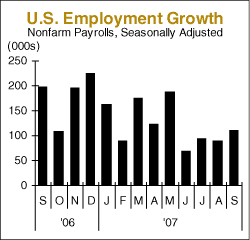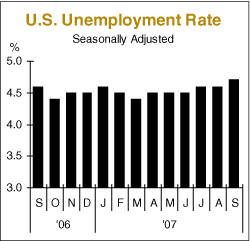|
October 10, 2007 (you may need to refresh your browser to view the latest issue)
The Infamous “R” Word
(not recession…revision!)
Written by Jeff Thredgold, CSP, President, Thredgold Economic Associates
I have a full head of hair (which has been graying in recent years). Even at my advanced age of 56, my long-time barber still tells me I have the thickest head of hair she has ever seen. I thank my parents, their parents, their parents before them, etc. for this fact.
What is amazing is that I have any hair on top at all…given the wild gyrations of economic data and subsequent revisions to prior data that simply blow formerly held views out the window…
 For Example For Example
Case in point is the September employment report. The U.S. economy added 110,000 net new jobs during September, very close to economists’ expectations. What was hair damaging was the revision to employment data of the prior month.
Remember the pervasive economic doom & gloom which immediately followed the release of the August employment data on September 7? Remember all those economic naysayers and politicians who grabbed on to the data as indisputable evidence that an American recession was imminent…if not already underway?
As you might recall from September 7, the U.S. Department of Labor’s Bureau of Labor Statistics noted their estimate that American employment had actually declined in August by 4,000 jobs. Say it wasn’t so! For the first time in four years, reported employment had declined. Woe unto us all!
You might also recall that the Federal Reserve surprised Wall Street with a one-half percent cut in its key interest rate on September 18, in part a response to fears of even weaker employment data in following months.
Oh!…I forgot to mention…The Bureau of Labor Statistics noted in its October 5 report regarding September employment data that the August estimate was revised from a loss of 4,000 jobs to a gain of 89,000 jobs!! Mercy! The BLS also mentioned that the July employment gain was revised higher by another 25,000 jobs!
What a Difference a Day Makes
The bottom line is this…estimated U.S. employment through September is 228,000 more than was the case following the initial release of the August data…more jobs…more incomes…less likely recession.
Following the initial release of the ugly August data, we reiterated our view that U.S. recession was not likely, although the chance had risen to perhaps 40%. Based on the Fed’s very market-friendly 0.50% cut to 4.75% in its key federal funds rate on September 18, we suggested the odds of recession had declined.
Our view continues that a recession remains unlikely. Yes, the housing market is in distress in dozens of communities around the nation where prices went too far too fast, or where auto-related employment cutbacks have weakened communities.
The average U.S. home value rose 50.76% during the five-year period ending on June 30, 2007 (source: OFHEO). High-flyers Arizona, California, Florida, and Nevada were states that saw home values jump on average more than 90% during that five-year period…
…these states now struggle with soft prices, overbuilt markets, rising delinquencies and foreclosures, and serious subprime mortgage lending challenges.
Weakness in housing is largely offset by strength in U.S. exports to the world. Powerful global economic performance and a weaker U.S. dollar have fueled record levels of American exports to the world. Strong export growth is leading this nation’s trade imbalance with our global partners lower for the first time in six years.
The Employment Data
As noted, the American economy added 110,000 net new jobs in September. Also as noted, estimated gains of the two prior months were revised higher by another 118,000 jobs. These estimates are derived from a monthly survey of roughly 375,000 medium and large-sized businesses…known as the establishment survey.
 Even as employment data was largely positive, the nation’s unemployment rate actually moved higher in September, reaching a 13-month high of 4.7%, versus the 4.6% level of the two prior months. Why the rise in the nation’s unemployment rate? Why a rise when the monthly survey of 60,000 households (the source of the unemployment rate) actually estimated the impressive addition of 463,000 net new jobs in September? Even as employment data was largely positive, the nation’s unemployment rate actually moved higher in September, reaching a 13-month high of 4.7%, versus the 4.6% level of the two prior months. Why the rise in the nation’s unemployment rate? Why a rise when the monthly survey of 60,000 households (the source of the unemployment rate) actually estimated the impressive addition of 463,000 net new jobs in September?
Why? Because the estimated civilian labor force…those people actively employed or actively seeking employment…rose by an estimated 573,000 people in September, thereby leaving 110,000 more people “unemployed”…573,000 new entrants minus 463,000 with new jobs. Keep in mind that people tend to enter the labor force when they feel that jobs are more likely to be available.
Struggling
All is obviously not well in the economy…no argument here. The goods production sector of the U.S. economy lost another 33,000 net jobs in September. The nation’s construction sector suffered a net decline of 14,000 jobs in September, with gains in commercial construction activity not enough to offset losses in new home construction. The nation’s manufacturing sector lost 18,000 jobs in September, the 15th consecutive month of decline.
Service providing sectors led the way with a rise of 143,000 net new jobs. The education & health services sector added another 44,000 jobs, while the government sector added 37,000 jobs. Leisure & hospitality added 35,000 jobs, while professional & business services added another 21,000 positions.
Good news saw a solid rise in wages. Average hourly earnings for production and non-supervisory workers rose 0.4% (up seven cents) to $17.57 hourly. The 4.1% rise over the past 12 months was the largest year-over-year rise since February. More importantly, the 4.1% rise sharply exceeds the 2.0% rise in the Consumer Price Index for the 12 months ending in August, leading to solid growth in real (inflation adjusted) wages.
At The Fed
Stronger numbers from the nation’s employment sector will temper the Fed’s willingness to cut its important federal funds rate further. Solid gains in stock prices of recent weeks will also induce the Fed to the monetary sidelines.
Odds of the Fed cutting its key rate by 0.25% (to 4.50%) on Halloween have diminished to perhaps one in three, although we would place the likelihood slightly higher. The Fed could keep policy unchanged at the October 31 meeting with an option to act on December 11.
In any event, the Fed will closely monitor financial market and economic developments in coming weeks. In a nutshell, the Fed will respond IF necessary. The Fed’s preference to do nothing in coming months may also come to fruition.
Email this article to a friend
|
|
Subscribe to the Tea Leaf
Like what you just read? Have Jeff Thredgold’s Tea Leaf emailed to you free each week. Subscribe today.
|
|
|

“Tea”ser
Dogs have owners. Cats have staff.
Send us a “Tea”ser of your own.

“Tea”stimonial
“You were great! And, yes, economics can be ‘entertaining and humorous.’ Early feedback shows that yours may have been one of the best overall sessions we have ever had. It’s tough being the ‘last act’ on a Saturday morning, but I didn’t see a single participant leave after the break. Kudos to you for a job well done.”
—M. Lance Miller, CAE, EVP, Metal Treating Institute
More testimonials
Invite Jeff Thredgold to speak at your next conference, meeting, or client function
If you like the Tea Leaf, you’ll love Jeff Thredgold’s live presentations. Jeff takes your audience on a timely, engaging, and entertaining tour of the U.S. economy and financial markets. Debunking some of today’s most common economic myths, he offers a clear picture of how the American economy is really performing and what that means for the future of your finances.
|

